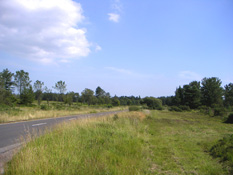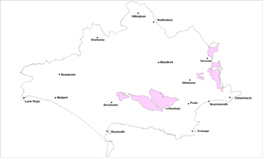Heath / forest mosaic


Location
The Forest Heath landscape type forms part of the wider ‘Poole Basin’, an extensive and expansive area of former heathland on acidic and impoverished soils.
Key Characteristics
- an extensive and expansive landscape with an unspoilt feel over a large proportion
- a mosaic of heath, forest and scrub on impoverished sandy soils
- extensive stands of conifer plantation on former heathland sites
- varied landform but generally on elevated areas subdivided by a series of river valleys
- forms a ‘buffer’ between the chalk landscapes, river valleys and other heathland landscape types
- straight roads lined by woodland/forest/grass/scrub mosaic
- significant impacts created by urban development such as industrial, military use, quarrying, housing and transport corridors
- important open vistas from key viewpoints
- area popular for informal recreation activities as well as for nature conservation
The Heath/Forest Mosaic type is a transitional area between the chalk landscapes, river valleys and other heathland landscape types and in the east extends over the border into Hampshire. It has a varied landform from undulating in the west with steeper slopes in the east of the county. It is generally formed on elevated plateaus or ridges cut by the rivers Avon, Moors, Sherford, Piddle and Frome. It is characterised by a patchwork landscape of heath, forest and scrub on sandy soil with extensive blocks of conifer plantation and areas of regenerating birch woodland to create a distinctive mosaic. The conifer plantations blanket former heathland sites often in extensive stands with their margins often creating striking ‘sharp edges’ but can help to soften urban development. The urban influences of housing, military and industrial development impact significantly on the area, which is well used and popular for informal recreation. Bovington Camp creates a significant impact over a wide area to the west of the area as does quarrying operations. Urban fringe pony/horse paddocks and its associated ‘clutter’ create more localised but still significant impacts. In the east of the county the fringes of the conurbation butt hard up to the edges of this landscape to create harsh edges in places. The straight roads are often edged by a mix of mature and regenerating woodland, open heath and plantation. There are a number of key viewpoints with important open views across the wider landscape such as from Town Common, St. Catherines Hill, the picnic sites along the ridge at Affpuddle Heath and from within elevated parts of Wareham Forest. There are a number of important recreational sites in this area such as Avon Heath and Moors Valley Country Parks. Wareham Forest, Puddletown Forest, West Moors Plantation, Town Common, Sopley Common and St. Catherine’s Hill are all key features in the area particularly because of their open space and landscape value.
Management Objectives
The overall management objectives for the Heath/Forest Mosaic Landscape Type should be to improve and enhance the hard geometric edges to conifer plantations, continue to vary landscape and forestry operations to create diversity and multi functional mosaic landscapes and enhance the ecological value of heathland. Key features that need to be conserved and enhanced include skyline trees and trees which help to soften urban development, the designated sites of nature conservation and cultural heritage interest and the heathland areas to reduce fragmentation.
Key land management guidance notes
- continue to enhance forestry areas to add landscape and conservation diversity for example along key ridge tops and by the phased reduction in the proportion of conifers
- maintain a mosaic of habitats through management
- carry out river corridor management along fringe areas of the Piddle and Frome to create naturalistic environments and a range of habitats
- manage and enhance blocks of plantation woodland as landscape features and to help screen urban/military uses
- to help reverse the fragmentation of the heathland, promote heathland restoration from conifer plantation and marginal agricultural land so as to create large and continuous habitat mosaics that are predominantly heathland and managed by extensive grazing
- control and manage misuse of the area such as arson, tipping and vandalism
- promote a multi functional approach to land management to provide recreational, landscape, biodiversity and economic benefits focussing recreational activities away from sensitive heathland habitats
- control the spread of alien invasive plant species such as Rhododendron and Gaultheria
- promote/encourage the production of a comprehensive Landscape Design/Management Restoration Masterplan for Bovington
- control and manage urban fringe uses such as ‘horsiculture’ to reduce their landscape and visual impacts e.g. through careful design & site planning, planning policy development and/or voluntary codes of practice
- identify, protect and conserve key views e.g. via Parish Action Plans, Village Design Statements and other Settlement Appraisals
- soften hard geometric edges to plantations especially along highways and other public rights of way through small scale broadleaved native planting and/or via natural regeneration.
